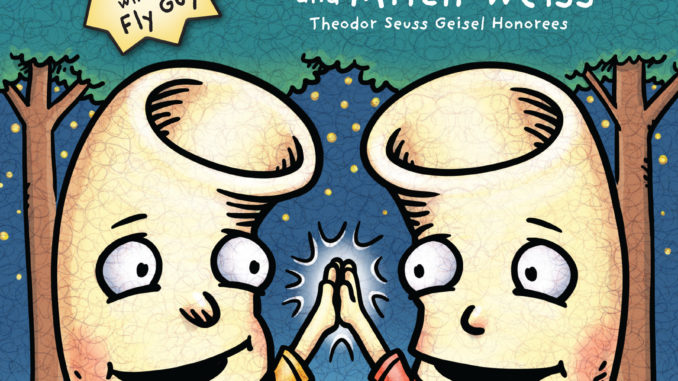
Review Fix chats with Tedd Arnold, Martha Hamilton and Mitch Weiss who discuss their fun creative process and goals for the series.
About Noodleheads Do the Impossible: This sixth book in the Noodleheads graphic novel series is perfect for comic fans and reluctant readers. Short chapters—full of wordplay, jokes, and slapstick humor—follow Mac and Mac through their funny adventures on their quest to be famous. Based on traditional world folktales and stories of fools, the Noodleheads encourage critical thinking by inviting readers to use their noodles to spot holes in the brothers’ grand plans. Click here to check out the full Noodleheads series and tons of fun extras.
Review Fix: How did you know a career in comics/graphic novels was for you?

Mitch Weiss and Martha Hamilton: Tedd made us do it! Just kidding! But the idea of turning our traditional, spoken, noodlehead folk tales into comic book form never would have occurred to us. Early in our discussions with Tedd about a Noodleheads series, he made some sketches that helped us visualize the possibilities and we were sold on the idea.
Tedd Arnold: Actually, when I embarked on what became my career of writing and illustrating picture books for young readers, it never occurred to me it would one day lead to working in the comic or graphic novel form. When I was young, like most kids, I read comics, but I didn’t get inspired to draw cartoons until I discovered Mad Magazine while in 6th grade. Later I collected, not super-hero comics, but the more alternative comics that were called “underground comics†or what I now describe as “hippie comics.†I recall once, as an author, I was speaking to an audience of teachers and librarians about my picture books. Someone asked a simple question, “Are there picture books published for adults?†It gave me pause because I at first I was thinking only of the traditional picture book form I had been creating. Then the obvious hit me. “Yes, comic books!†Comics are typically perceived to be a low art form and “just for kidsâ€, but in fact, these days, the vast majority of readership is adult. Only in recent years has the graphic novel become a valued literary form for kids and a powerful tool for encouraging reading.
Who inspires you creatively?
TA: My wife, Carol, was a kindergarten teacher and inspired my interest in picture books. I became a student of Dr. Seuss, Maurice Sendak, Arnold Lobel, James Marshall and countless others. The gentle humor of Arnold Lobel’s Frog and Toad books and the raucous humor of any of James Marshall’s work—their humor is what has guided me. Also, back when I was learning about my wife’s children’s books and just discovering Maurice Sendak, it was not lost on me that Where the Wild Things Are was inspired by an early 20th century newspaper comic strip called Little Nemo in Slumberland by Windsor Mckay. Subsequently, Sendak’s book, Mickey in The Night Kitchen was a full fledged comic book disguised to look like a picture book.
Review Fix: How are your comics/graphic novels different or special?
TA: In fact, as the artist for the Noodleheads, I try to NOT be different or special. I revel in the traditions of the comic book arts. My art style is not overly detailed or busy with background scenes. Thus my cartoons are more akin to the simplicity of the newspaper comics like Peanuts and Garfield.
MW and MA: As storytellers who tell stories in front of audiences, we use facial and vocal expression, hand gestures, and body language to visually represent the content and emotions of a story. Our listeners simultaneously create their unique “movie†of the story in their mind’s eye. A subtle hand movement or the raising of an eyebrow can speak volumes. Working with Tedd on these graphic novels has been interesting—and at times challenging. We have to always keep in mind that Tedd will be visually representing the story on the page—and how different that can be from simply telling an oral story. For example, we’ve enjoyed telling a noodlehead story about two fools who loved to go horseback riding together—but they had a hard time telling their horses apart. They tried various ways of telling them apart such as one fool trimming his horse’s mane—which worked until the mane grew back and they again couldn’t tell them apart. The punchline is that one fool finally got the idea to measure the horses with a yardstick and they found that the brown horse was several inches taller than the white horse with black spots! During an oral telling, the listeners see two nondescript horses in their imaginations when the horses are first mentioned. However, the illustrator would need to draw the specific horses—so it’s difficult to make this story work in an illustration.
TA: The aspect of the comic book form that I enjoy most is one that is totally different from traditional picture books. Consider how a typical picture book may devote one illustration to a particular interaction between characters. In the comic form, I can divide up the action into multiple panels on the page and illustrate the many varied facial expressions and postures the characters might go through. I like to think that, in this way, my comics are similar to the storyteller’s oral performance while acting out the scene with face and hand gestures.
Review Fix: Who do you think will dig it the most?
TA: Anyone who likes to laugh!

MW and MA: Everyone who has done something foolish at one time or another! Tales of fools, also traditionally called “noodleheads†have been told for as long as stories have been told.
Review Fix: How do you want your books to be remembered?
MW and MA: Just remember them! Retell them! Keep the stories alive.
TA: I hope that one of my books will be remembered by some young reader as the book that got them interested in reading.


Leave a Reply